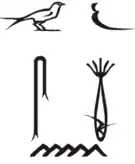Wadjenes
Wadjenes (ancient Eyptian Wadj-nes, which means "fresh of tongue"), also known as Wadjlas, Ougotlas and Tlas, was an early Egyptian king who may have ruled during the 2nd Dynasty. Since the name form "Wadjenes" is not contemporarily attested as the name of a king, but frequently appears in Ramesside kinglists, Egyptologists to this day are trying to connect Wadjenes with contemporary Horus-kings.
| Wadjenes | |||||||||||||||||||||||
|---|---|---|---|---|---|---|---|---|---|---|---|---|---|---|---|---|---|---|---|---|---|---|---|
| Wadjlas, Ougotlas, Outlas, Tlas | |||||||||||||||||||||||
 Cartouche name of Wadjenes in the Abydos King List (cartouche no. 12) | |||||||||||||||||||||||
| Pharaoh | |||||||||||||||||||||||
| Reign | length of reign unknown (2nd Dynasty; around 2740 B.C.) | ||||||||||||||||||||||
| Predecessor | Banetjer | ||||||||||||||||||||||
| Successor | Senedj | ||||||||||||||||||||||
| |||||||||||||||||||||||
Name sources

The king's name "Wadjenes" is attested only in the Ramesside kinglists, where he is always presented as the immediate successor of king Nynetjer and as the predecessor of king Senedj. The same goes for the Royal Canon of Turin, where the entry for his name is damaged so only the years of rulership are preserved.[1][2]
Whilst all kinglists match each other regarding the chronological position of Wadjenes, Egyptologists are uncertain as to the origin of the name "Wadjenes". Egyptologists and historians such as Winfried Barta, Bernhard Grdseloff and Iorwerth Eiddon Stephen Edwards believe that the papyrus haulm, the first symbol in Wadjenes's name, is a misinterpretation of the hieroglyphic sign of a flower called Weneg (also read as Uneg), which is rarely used in Egyptian writing. A king Weneg (also written as "Weneg-Nebti") is also contemporarily identified by black ink-inscriptions on alabaster-shards and as incised writings on schist vessels originating from the underground galleries beneath the step pyramid of king Djoser at Sakkara. It is possible that Ramesside scribes interchanged the Weneg flower with the papyrus haulm, since both signs are very similar to each other in hieratic script.[3][4][5]
Besides the artefacts with the name "Weneg-Nebti", further objects made of alabaster show the personal name "Wadj-sen" in connection with the Sed festival. Egyptologists such as Wolfgang Helck think that Wadj-sen was a crown prince, since the titulary Wer-ma'a ("he who sees the greatest") was always reserved for the eldest son of a king and so it is also connected with Wadj-sen's name. However, Egyptologists such as Peter Kaplony and Jürgen von Beckerath believe that Weneg-Nebti and Wadjenes are identical and that Wadjenes's Horus name was Sekhemib-Perenmaat or Horus Sa.[6]
The ancient Egyptian historian Manetho called Wadjenes "Tlas". This name distortion may be based on the Coptic rewriting of the name "Wadjenes" as "Ougotlas", meaning ″fresh of tongue″.[7]
Reign
Very little is known about Wadjenes's reign. The Turin King List lists Wadjenes as ruling for 54 years, whilst Manetho assigns 17 years to him. Egyptologists evaluate both lists as misinterpretations by Ramesside scribes or as an exaggeration. If Wadjenes was an independent ruler (as Richard Weill and Peter Kaplony believe) he was evidently the last to rule over a unified realm, since his name is found in both Memphite and Thinite royal chronicles. It is largely accepted by Egyptologists that the immediate successor of king Nynetjer left a divided Egypt, which was headed by two kings who ruled at the same time. The theory is based on the unusual serekh name of a king called Peribsen, who succeeded Nynetjer and who placed the crest animal of Seth above his name. Since the deity Seth was of Ombite origin, king Peribsen was probably of Ombite origin, too, and he definitely ruled only in Upper Egypt. His name is missing from the Ramesside Memphite kinglists, because they were all written by Memphite priests and they did not accept any non-Memphite ruler as a rightful ancestor.[2][3][4][5]
References
- after: Alan H. Gardiner: The Royal Canon of Turin. Griffith Institute of Oxford, Oxford (UK) 1997, ISBN 0-900416-48-3; page 15 & Table I.
- Walter Bryan Emery: Ägypten. Geschichte und Kultur der Frühzeit. Fourier-Verlag, Wiesbaden 1964, ISBN 3-921695-39-2, page 275.
- B. Grdseloff: King Uneg in: Annales du Service des Antiquités de l’Égypte, No. 44, 1944, page 279–306.
- Winfried Barta in: Zeitschrift für Ägyptische Sprache und Altertumskunde, No.108. Akademie-Verlag, Berlin 1981, ISSN 0044-216X, page11.
- Iorwerth Eiddon Stephen Edwards: The Cambridge Ancient History, Vol. 1, Pt. 2: Early History of the Middle East, 3rd reprint. Cambridge University Press, Cambridge 2006, ISBN 0-521-07791-5, page 31.
- Wolfgang Helck: Untersuchungen zur Thinitenzeit. Otto Harrassowitz, Wiesbaden 1987, ISBN 3-447-02677-4, page 142
- I.E.S. Edwards: The Cambridge ancient history, Volume 1-3. Cambridge University Press, 1970, ISBN 0-521-07791-5, page 31.
| Preceded by Weneg (pharaoh) |
Pharaoh of Egypt | Succeeded by Senedj |
